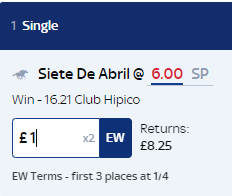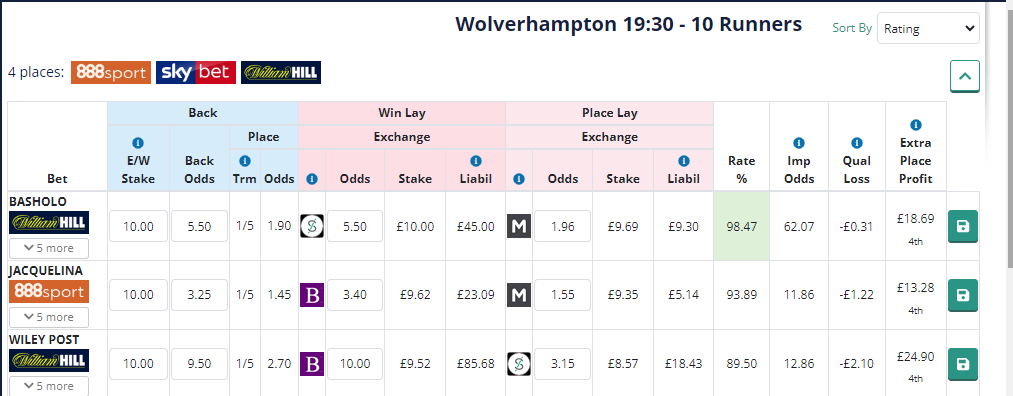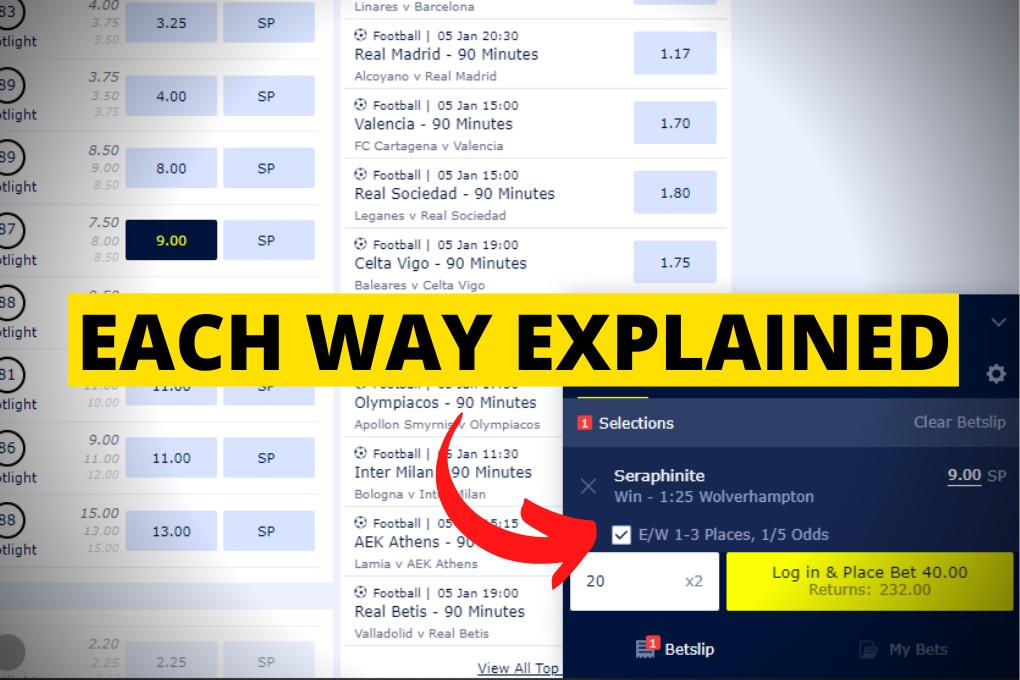Each Way Betting can be a little tricky to understand when you first start out. But once you fully grasp it you will see why each way betting is such a popular bet, In this article we explain exactly what each way betting is!
An each-way bet is the most popular bet in the Grand National when most of the general public take a punt on the big race. On races with large fields betting each way is often the best way to get value.
What Does Each Way Betting Mean?
An each-way bet is made up of two parts. There is a win part and a place part – hence you can win either way. This is why your stake is double that of a single win bet.
A £10 each way bet will cost you £20 in total:
- £10 on the win
- £10 on the place
Where each way betting gets tricky for newcomers is the bookmaker’s place terms, and the places change depending on the number of runners in the race.
In this article, we’re going to run through everything you need to know about each way betting and by the end of it, you’ll be an expert!
As an additional bonus we are also going to include a profitable each way betting strategy.
How Does Each Way Betting Work?
Each way betting is easy to understand when you know the terms. There are some basic rules to follow, and we’re going to explain these below. As we said above, an each-way bet is two bets, one win and one place combined.
The win part is easy to understand. If the horse wins you make a profit, if it doesn’t you lose your bet.
The place part will change depending on the number of runners in the race and also what terms the bookmaker is offering. The basic place rules for betting on horse racing are as follows, however, we have to break them down into Graded races and Handicap races:
Graded Races Each Way Terms:
- 2 to 4 runners = win only
- 5 to 7 runners = two places
- 8 or more runners = three places
The biggest difference between Graded races and Handicap races is that there can be 16 or more runners in a Group 1, but it’s still three places unless the bookmaker offers an “extra place” offer.
Handicap Races Each Way Terms:
- 2 to 4 runners = win only
- 5 to 7 runners = two places
- 8 to 15 runners = three places
- 16 or more runners = four places
The next variable is the bookmaker terms for each-way betting. The first thing to consider is are they offering an extra place?

For example, some bookmakers can offer up to eight places on the Grand National. That is a unique situation though because there are 40 runners. You are more likely to see five places from a bookmaker when there is 20 runners in a normal midweek race for example.
These are also special offers that certain bookmakers will do from time to time, and they can be quite valuable, as we will discuss later in this post.
However, let’s focus on the main bookmaker terms. One of the most important things about each way betting is what odds you are getting in the place terms.
Place Terms
The place terms can range from 1/3 to 1/6. Basically, that means you divide the win part by the place terms to come up with your price. An easy example is 1/4 place terms and the selection is 4/1. You divide 4/1 into 1/4 and you get 1/1 – which is evens (Decimal odds of 5.0 becomes 2.0 place odds).
The most commonplace terms are 1/5, as bookmakers tend to try and stay away from 1/4 these days.
A general rule of thumb might be:
- 5 to 7 runners = 1/4 odds
- 8 to 15 runners = 1/5 odds
- 16 or more runners = 1/4 odds
These terms can vary wildly depending on your bookmaker, so pay attention to what place terms they are offering.
Something else to be aware of when each way betting is non-runners. Having a non-runner in the race can completely change the places.
For example when you place your bet there might be eight runners in a race, which means we will be getting three places. However, if there was a non-runner the places would be reduced to two.
Each Way Betting Real Example

Let’s break down a real each way bet to make sure you fully understand how each way betting works.
In the image above you can see that I want to place a £1 bet on the horse Siete De Abril at odds of 6.0 (5/1) and I have chosen to back it each way at terms of 1/4. This means I will be staking £2, let’s go over the outcomes.
-
Siete De Abril loses = -£2
-
Siete De Abril wins the race = £8.25 is returned, £6.25 of that is profit. £5 profit is made on the win bet, £1.25 is made on the place bet.
-
Siete De Abril loses the race but finishes in the top 3 = £2.25 is returned, £0.25 of that is profit. -£1 is lost on the win bet, £1.25 profit is made on the place bet.
Those are the only 3 outcomes that can happen once your bet placed, Along with the bet potentially being a non runner in which case all funds are returned from the bet.
How To Make Money Each Way Betting (Mathematical Strategy):
Each-way betting can be very profitable if you have the right strategies!
In horse racing, you may have heard the term “bad each way race,” this means that it’s a bad each-way race for the bookmaker and there is value on offer for the punters. A classic example of a bad each-way race might be eight runners with five outsiders and three horses towards the head of the market. The favourite might be 5/4 and then the second favourite is 7/2 and the third favourite 9/2.
The strategy is to back the second or third favourite each way because there is value in the place part of the bet. If you divide 9/2 by 1/5 you get odds of 1.9 to place – but the true price of placing could be much lower because of the make-up of the race.
In the place-only market on Betfair, the price might be trading at 1.6 for example. Plus, you have the added bonus of the third favourite actually winning the race. These are the types of races and situations that bookmakers hate, and they generally don’t like laying those types of each-way bets. It’s fantastic value for the punter.
Check out this video guide:
Extra Places
Another good each-way betting strategy is to use the extra place offers from bookmakers to profit. Much like the above strategy, there is a small risk involved, but overall the strategy is very profitable.
Let’s assume there is a big 20-runner handicap at Newbury. The general place terms are four places, however, SkyBet has enhanced the place market to six places. Because we get four places with sixteen or more runners on a handicap, the place market is only four places on Betfair Exchange.
The strategy is to try to find a horse closely priced between the SkyBet prices and the Betfair prices, then go back with SkyBet and lay the bet with Betfair. If the horse finishes 5th or 6th, you collect your each-way bet from SkyBet, but you also collect your winning lay from Betfair Exchange because it was only four places.

Oddsmonkey is a great piece of software that can pinpoint these opportunities in seconds. You can read our review here.
The above strategy can be very profitable, however, when the horse doesn’t finish in the sweet spot (5th or 6th), you will lose a small bit of your stake.
For example, let’s assume you bet £50 each way – by the time you lay off on Betfair Exchange the “qualifying loss” will probably be between £15 and £20. However, if the horse were to finish 5th or 6th you would win around £100, based on the average 9/1 shot.
The theory behind the strategy is just as solid as the bad each-way race theory, essentially you have the odds in your favour each time, and while you won’t collect every time, over the course of the year you will win more than you lose.
Building your understanding of each way betting is a key component in profiting from the sport horse racing. Pairing this knowledge with expert tips can allow you to push your profit margins even further!
Enter Insider Edge Bets—a leading betting tipster service renowned for delivering well-researched, value-driven tips backed by insider industry information. Specialising in horse racing, Insider Edge Bets ensures you stay ahead with real-time tips delivered via a private Telegram group. Their proven track record of profitability makes them the perfect partner for those looking to maximize their returns on horse racing betting.
Click here to check it out now!
When To Not Bet Each Way Explained…
We’ve highlighted a couple of excellent each-way strategies above, but there are also times when you shouldn’t bet each way. As you would have noticed above too, you can’t bet each way when there are less than five runners in a race. Even though there is an each-way option for up to seven runners, we wouldn’t recommend betting each way when there are only two places on offer. This is just something that most often isn’t value, and it’s best avoided unless you’re really confident it’s a value play.
It is also advisable not to bet each way when the odds are low.
For example, there’s very little value in betting each way on a 6/4 shot. Some punters bet each way at 2/1 – the place odds are 1.4 which is 2/5, this can offer marginal value, but you’re probably better off backing the horse in the place market on Betfair. There would only be a handful of situations where the horse would be trading under 1.4 in the place market on Betfair Exchange – the most likely races this can happen is maidens.
The best and easiest way to find value betting each way is to check the place market on Betfair Exchange. The place market on Betfair is Place Only and very simple to understand. It will help you spot the “bad each way” prices and profit from the bookmaker each-way terms.
Related: Arbitrage Betting: 5 Secrets for Massive Risk-Free Profits!


2 thoughts on “Each Way Betting Explained For Beginners: From Novice to Pro in 5 Minutes”
Thanks for breaking down each way betting into easy to understand language. Your examples really helped clarify the concept for me. Now I feel more confident to try out this type of bet.
This post is incredibly helpful for someone who’s just starting to explore each way betting! The breakdown of the concepts made it clear and easy to grasp. I particularly liked the examples you provided—really brought the strategies to life. Thanks for sharing such valuable insights!